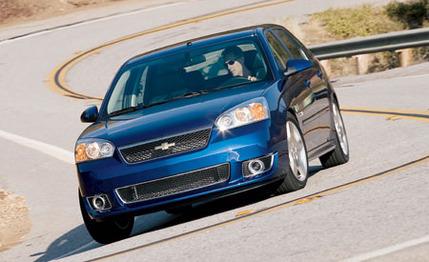
 Road Test
Road Test
This Malibu Maxx SS painted in Laser Blue Metallic is about the same color as the bolt of lightning that killed my pal Jeff's 1974 Cadillac. Actually, it wasn't lightning so much as an electrical arc. Maybe it was an electrical arc; we don't know for sure. The old Caddy just stopped running one day while we had a screwdriver stuck down its distributor.
Who's Jeff? He is a GM man, one of the few from Generation X. He lives in the Long Island suburb of Plainview-we're not making the name up-with his wife and new baby, his antique Cadillac, an Oldsmobile Alero, and a Chevy Malibu company car. He drives about 50,000 miles a year and goes for a spacious vehicle that doesn't cost much and gets decent fuel economy. The Malibu Maxx SS makes him hot. "As a company rep, I aspire to that car."
Chevy has been putting traveling salesmen in a sweat for 45 years by gluing the Super Sport badge to workaday sedans. The Malibu Maxx, Chevrolet's slightly funky, somewhat frumpy bobtail wagon was burning for the SS treatment from day one, which for the Maxx came in 2003.
True, the Maxx is already a Gauloises-smoking bohemian at the Chevrolet of baseball, hot dogs, and apple-pie fame. It rolls on GM's front-drive Epsilon platform, which it shares with European cosmopolitans from Saab and Opel. To American eyes, the body is a somewhat runty-looking cross between a family sedan and an ice chest, but it speaks to the Continental preference for hatchbacks. The chassis is also stiff and relatively sophisticated. Check out those cast-aluminum arms in the multilink rear suspension. Were autobahns consulted in the making of the Maxx?
With a thick spear of chrome splitting its face, the old Maxx looked as if it were wearing orthodontic headgear. For 2006 the Maxx gets a more straightforward array of grilles, and the SS receives extra silver accent rings. It's a simple change that, like having braces removed, works wonders for the smile. The SS also receives a spoiler on the hatch, some rocker cladding below the doors, and a square-jawed front bumper with a chin spoiler and fog lights. Inside the 225/50 Goodyear Eagle LS-2 tires are 18-inch alloy wheels with five very thick, very square spokes that look ready for the big torque.
The SS badge is really about the engine, and at the $24,690 base price (ours had only a $325 satellite-radio receiver increasing its sticker), the Maxx SS gets more of it. This is still a 60-degree iron-block pushrod V-6-and you were expecting . . . what?-but the bores grow by three millimeters and total displacement rises from 3.5 liters to 3.9. A variable-length intake plenum optimizes airflow, and a new variable-valve-timing system rotates the cam to crack open the intake valves (and yes, the exhaust valves, too) earlier or later depending on the motion of your right foot. That's a first for "cam in block" engines, says GM.
Snigger if you wish. Say that's like being first out with a black-and-white plasma-screen TV, but pushrod cam phasing is a new wrinkle worth noting and a widget that even the Corvette doesn't have.
Ultimately, easier breathing is what the fuss is about, and the 3.9 revs hard and fast with an unusually crisp song that we're unaccustomed to in GM's pushrod V-6s. It also doesn't gasp at the far end of the tach, winding to the 6200-rpm redline with a steady, consistent push. We'd be hooting even louder if this 3.9 were making, say, the same 250 horsepower and 242 pound-feet as the overhead-cam 3.5-liter V-6 in the Saturn Vue Red Line. That engine, by the way, is made by Honda, which knows a thing about squeezing out horsepower. Output from the Maxx SS is 240 horses at 5800 rpm and 240 pound-feet of torque at 2800 rpm, which is still an upgrade of 39 horsepower and 19 pound-feet over the 3.5-liter V-6 in the Maxx LT and LTZ.